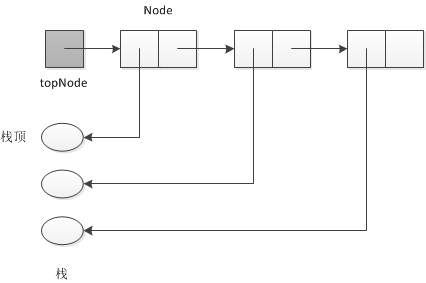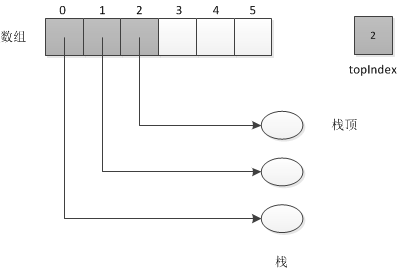栈 Stack
|
|
|
1. 栈 List 定义 栈是限制插入和删除只能在一个位置上进行的表,该位置是表的末端,叫做栈顶。 栈有时又叫做LIFO(后进先出)表,即last-in,first-out 现实中的栈
栈的接口 public interface StackInterface<T> {
/**
* 将新元素加到站定
* @param newEntry 带插入站的对象 */
public void push(T newEntry);
/**
* 删除并返回栈顶
* @return 栈顶的对象,如果栈为空则返回null */
public T pop();
/**
* 取出栈顶
* @return 栈顶的对象,如果栈为空则返回null */
public T peek();
/**
* 检查栈是否为空
* @return 如果栈为空返回true */
public boolean isEmpty();
/**
* 从栈中删除所有元素 */
public void clear();
}程序栈 当一个程序执行时,一个被称为程序计数器的专用存储单元指向当前指令。当一个方法被调用时,程序的运行时环境为这个方法创建一个称为活动记录或栈帧的对象,这个活动记录显示该方法在执行过程中的状态。具体说,活动记录含有方法的实参、局部变量和当前指令的引用,即程序计数器的一个副本。在这个方法被调用时,活动记录被压入称为程序栈(或者称为Java栈)中。 由于一个方法可以调用另一个方法,程序栈往往含有多个活动记录。位于栈顶的活动记录,属于当前正在执行的方法,紧接在栈顶下的记录,属于调用当前方法的方法。 Java类库:类Stack public class Stack<T> {
public T push(T item);
public T pop();
public T peek();
public boolean empty();
/**
* 在栈中查找指定对象
* @param desiredItem 待查找的对象
* @return 如果desiredItem在栈中,则返回其位置;如果不在则返回-1;栈顶的位置是-1 */
public int search(T desiredItem);
/**
* @return 栈的一个遵循Java接口的Iterator的迭代器 */
public Iterator<T> iteraotr();
/**
* @return 栈的一个遵循Java接口ListIterator的迭代器 */
public ListIterator<T> listIterator();
}2. 基于链表的实现 如果用链表表示栈,则第一个结点应该引用栈顶元素。 类的框架 栈的链表实现有一个数据域topNode,它是链表的表头引用,默认构造函数将这个数据域设置为null。
public class LinkedStack<T> implements StackInterface<T>, Serializable {
private Node topNode; //引用链表中第一个结点
public LinkedStack() {
topNode = null;
}
private class Node implements Serializable {
private T data; //栈的元素
private Node next; //指向下一个结点的连接
}
// 在栈顶插入
public void push(T newEntry) {
Node newNode = new Node(newEntry, topNode);
topNode = newNode;
}
// 删除栈顶
public T pop() {
T top = null;
if (topNode != null) {
top = topNode.getData();
topNode = topNode.getNext();
}
return top;
}
// 检索栈顶
public T peek() {
T top = null;
if (topNode != null)
top = topNode.getData();
return top;
}
public boolean isEmpty() {
return topNode == null;
}
public void clear() {
topNode = null;
}
}3. 基于数组的实现
public class ArrayStack<T> implements StackInterface<T>, Serializable {
private T[] stack; //存放栈元素的数组
private int topIndex; // 栈顶元素索引
private static final int DEFAULT_MAX_SIZE = 50;
public ArrayStack() {
this(DEFAULT_MAX_SIZE);
}
public ArrayStack(int initialCapacity) {
stack = (T[]) new Object[initialCapacity];
topIndex = -1;
}
// 在栈顶插入
public void push(T newEntry) {
topIndex++;
if (topIndex >= stack.length) {
//若数组已满,扩展数组
}
stack[topIndex] = newEntry;
}
// 删除栈顶
public T pop() {
T top = null;
if (!isEmpty()) {
top = stack[topIndex];
stack[topIndex] = null;
topIndex--;
}
return top;
}
// 检索栈顶
public T peek() {
T top = null;
if (!isEmpty())
top = stack[topIndex];
return top;
}
public boolean isEmpty() {
return topIndex < 0;
}
public void clear() {
stack = null;
}
}4. 基于向量的实现 public class VectorStack<T> implements StackInterface<T>, Serializable {
private Vector<T> stack; //栈顶是最后一个元素
public VectorStack() {
stack = new Vector(); // 需要时向变量大小将成倍增加
}
public VectorStack(int maxSize) {
stack = new Vector(maxSize);
}
// 在栈顶插入
public void push(T newEntry) {
stack.addElement(newEntry);
}
// 删除栈顶
public T pop() {
T top = null;
if (!isEmpty()) {
top = stack.lastElement();
stack.removeElement(stack.size() - 1);
}
return top;
}
// 检索栈顶
public T peek() {
T top = null;
if (!isEmpty())
top = stack.lastElement();
return top;
}
public boolean isEmpty() {
return stack.isEmpty();
}
public void clear() {
stack.removeAllElements();
}
}
转载请并标注: “本文转载自 linkedkeeper.com ” ©著作权归作者所有 |




